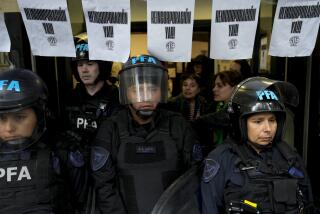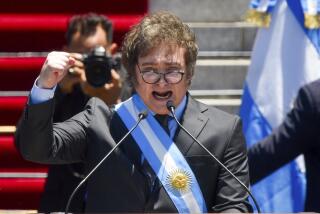How Argentina jump-started its economy
- Share via
Cristina Fernandez de Kirchner on Sunday became the first woman elected to the presidency of Argentina. Her victory is not difficult to explain. Her political party, under President Nestor Kirchner (her husband), led a dramatic economic turnaround that made Argentina the fastest-growing economy in the Western Hemisphere over the last 5 1/2 years.
More than 11 million people, or 28% of the population, were pulled above the poverty line as Argentina’s economy grew by more than 50%. Its 8.2% annual economic growth was more than twice the average for Latin America. Unemployment has dropped from 21.5% to 8.5%, and real (inflation-adjusted) wages have grown by more than 40%.
Fernandez’s victory was thus predictable and relatively easy. But the economic recovery that drove it was not so simple, and the people who led it deserve more credit than they have generally received. The Kirchners and their allies had to take on not only the conventional wisdom of the economics profession but also powerful international institutions such as the International Monetary Fund. Argentina’s success may have some important implications for other developing countries.
When Argentina defaulted on a record $100 billion of debt at the end of 2001, almost all of the experts predicted that this would be the beginning of a long period of punishment. International financial markets and foreign investors would shun the nation, they said, and this would be very damaging. The government had better reach an agreement with the IMF and follow its advice. And it had better play nice with the defaulted foreign creditors.
The experts could hardly have been more wrong. The economy contracted for just three months after the default and then began to grow. It hasn’t stopped since.
Contrary to a common belief, Argentina’s expansion was not based on exports or high commodity prices: Only about 13% of the growth during the expansion was because of exports.
What did Argentina do right? Most important, the government got its basic macroeconomic policies right. After years of seeing its domestic economy crippled by an overvalued currency that made imports artificially cheap, the Argentine central bank targeted a stable and competitive real exchange rate.
In other words, the authorities made sure that their currency didn’t rise too high and didn’t swing wildly as a result of movements in financial markets. (Here in the U.S., where we have shed more than 3 million manufacturing jobs since 2001 -- the bulk of them lost because of an overvalued dollar -- we might take note.) They also kept interest rates low and made growth, rather than the lowest possible inflation, the top priority.
These policies are mostly a no-no among central bankers and economists, and Argentina had a few showdowns with the IMF, including a brief temporary default to the fund in September 2003. But the fund backed down, and most of the defaulted international creditors ended up settling for 35 cents on the dollar in 2005.
Of course, Argentina hasn’t gotten a lot of foreign direct investment in the last five years, and it cannot directly borrow in international bond markets. But these handicaps -- which if you read the business press should spell doom -- turned out not to be all that important. Nor are they permanent. In time, foreign investors and lenders will find their way back to a fast-growing economy.
The lesson? Just as “all politics are local,” so too are the most important economic policies for most countries. Getting basic macroeconomic policies right for your own economy is a lot more important than pleasing international financial markets. That goes double for failed international financial institutions like the IMF. The fund not only oversaw the train wreck that collapsed Argentina’s economy from 1998 to 2002, it opposed the major policies that drove Argentina’s remarkable recovery.
The fact that Argentina’s break with the IMF and its policies was key to the country’s economic success also has implications for other countries. Over the last quarter of a century, the fund and its allied institutions -- run from Washington -- have presided over Latin America’s worst long-term growth performance in more than a century. As a result, most governments in the region have moved away from the IMF. Its loan portfolio in the region has shrunk from $49 billion just four years ago to less than $1 billion today. But it still holds sway in many poor countries.
Argentina’s new government will face challenges, the kind brought about by a fast-growing economy: keeping inflation in check and assuring adequate supplies of energy. But these problems are manageable. Of course, there are analysts who argue otherwise, but their forecasts over the last five years have not been very accurate.
Mark Weisbrot is co-director of the Center for Economic and Policy Research in Washington. Website: cepr.net
More to Read
Sign up for Essential California
The most important California stories and recommendations in your inbox every morning.
You may occasionally receive promotional content from the Los Angeles Times.










